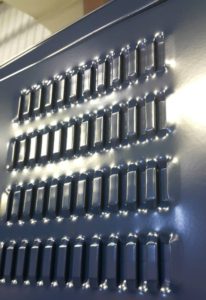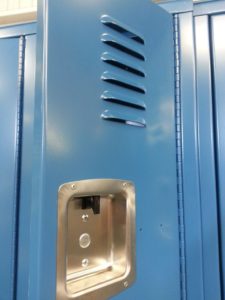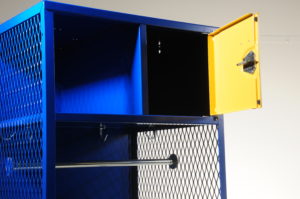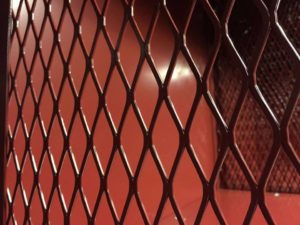When it comes to your locker’s construction, ventilation and security are on two sides of a swinging pendulum. While airflow is necessary to keep lockers from getting musty or stale, strong and solid walls are what protects the locker’s structure and your users’ contents.
And as we’ve mentioned before in our Framed or Formed blog, ventilation happens when material is taken out of the locker’s walls or door. And the more material that is taken away, the weaker the walls are. See where we are going with this?
Basically, you can have an extremely secure locker that has no ventilation, or a well-ventilated locker that is a bit less secure. What’s a locker buyer to do? We’re glad you asked because we have some answers.
Ventilation Methods
There are three main ways to improve ventilation in your lockers:
1. Expanded Metal
Here we use a different kind of material that comes already ventilated and is very similar to mesh, producing a piece of steel that has ventilation by design. On its own, however, without additional structural strength, this creates the weakest type of locker.
2. Removing Material
Diamond perforations are primary examples of this type of ventilation, which cuts out sections of the material to provide air flow. There is a wide range of choices you can make here to slide the scale towards more ventilation or more structure.
3. Deform Metal
There is one way to ventilate a locker without removing material — by cutting it and shaping it to make room for air to flow. “Secure-n-vent” is multiple three-dimensional vertical vents formed on the fronts and backs of the door, while “louvered ventilation” appear like tiny hooded slots. In this case, the metal is actually strengthened by the added rigidity to the door while still succeeding in providing some ventilation.
Ventilation for Hallway Lockers:
 Hallway lockers typically require lower ventilation, and it’s usually more important that the kids cannot get into each other’s lockers — or insert anything (trash, creatures, food, fluids, notes, etc.) into the lockers that could ruin its contents or threaten another student. For these reasons, schools often choose solid doors with no ventilation, strong lockers which give the hallways a sleek look and minimize opportunities for students to hurt themselves and each other.
Hallway lockers typically require lower ventilation, and it’s usually more important that the kids cannot get into each other’s lockers — or insert anything (trash, creatures, food, fluids, notes, etc.) into the lockers that could ruin its contents or threaten another student. For these reasons, schools often choose solid doors with no ventilation, strong lockers which give the hallways a sleek look and minimize opportunities for students to hurt themselves and each other.
Sometimes hallway lockers will have “louvers,” which look like little hoods and might only allow a piece of paper to get through, or “secure-n-vent” which are likely too small to fit even for a gum wrapper. These slots allow for some minor ventilation, which can be beneficial without removing material or allowing visibility. While the smaller percent of ventilation still allows airflow in case of rainy days and wet coats.
PE or Athletic Room Lockers
Because of the increased ventilation that is necessary for locker rooms, with damp clothes and equipment often left hanging, it’s rare to see solid locker doors. Diamond perforations and secure-n-vent, however, are popular options. Expanded metal mesh offers the maximum amount of ventilation, and is the only real way to get the best airflow in and out of a locker. But since it’s a much weaker material, and because it is so much less secure, this material is only found in PE or athletic rooms.
 Any perforations mean an increased visibility as well as weaker doors and walls. So the structures need to be secure enough to protect the items within, especially once they can be easily seen. Just how do we protect the locker when there is so much steel missing in the material we are using?
Any perforations mean an increased visibility as well as weaker doors and walls. So the structures need to be secure enough to protect the items within, especially once they can be easily seen. Just how do we protect the locker when there is so much steel missing in the material we are using?
The latch is critical. A multiple point latch provides slightly better security, with rods going into the top and bottom of the frame to keep it from being pried open. A single point latch can be strong enough, as long as the door is stiff and rigid enough so that it cannot be pulled away from the corner. A back panel stiffener is one way to keep the frame rigid, adding more material to all portions of the door that are not perforated.
The locker framing material, called ‘angle iron’ is a must have for any mesh doors. This L-shaped piece of steel is notched and bent into what looks like a picture frame and then welded onto the sides of the well-ventilated door. The angle iron makes the door resilient and helps it bounce back from any impact.
What kinds of impact? Well, it is a school locker room we’re talking about here! We’ve been asked before: “is a kid really going to hit a locker with a baseball bat or helmet?” The answer is, “well, heck yeah, they do!” In home or visitor locker rooms, this material gives it the strength to bounce back no matter what comes at it in the heat of a pre- or post-game moment.
Don’t Sacrifice Ventilation for Security any Longer!
As you can tell, we do a lot to our lockers to strengthen them and ensure you feel your items are secure. Security is really about deterring others from being able to pry into the door. Any opening could really be a possible way to get into the locker, so rigidity is key in making it impossible to bend the metal.
When choosing your lockers, you’ll have to decide whether security or ventilation is most important to your setting. But we’ve been at this a long time, and we can assure you that we will do our best to provide you with the best options for both security and ventilation. What are locker experts for, after all?
